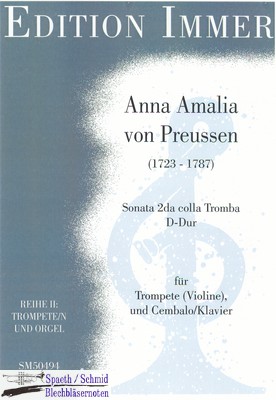
Anna Amalia von Preussen (1723-87), Sonata 2da colla tromba in D major for trumpet (or violin) and keyboard instrument (harpsichord, piano), edited by Arne Thielemann (Nagold: Musikverlag Spaeth/Schmid 2006) (Edition Immer, SM 50494), 20 euros.
Unbelievable! An original piece for trumpet and keyboard instrument written by the sister of Frederick the Great? Or perhaps it was only copied by her at the age of 12? The indefatigable Arne Thielemann’s detailed preface of this edition contains as much information as there is on the work.
The sonata for “tromba ô violin” is one of four contained in the manuscript Berlin, Prussian State Library, Amalienbibliothek 485. The other three are for violin and keyboard instrument. In addition, the manuscript also includes two concertos for violin and piano or harpsichord, although the solo part is missing from the second of these. The manuscript’s cover bears the date 10 December 1735, the keyboard part 3 July 1737. Thielemann writes: “As she was only 12 respectively [sic] 14 years old at the time …, it is not very likely that she also composed the pieces. It rather seems that she copied and/or transcribed existing pieces for her own musical education.” According to Klaus Hofmann, who published his own edition a year later, it now seems that the sonatas were copied by Anna Amalia’s sister Luise Ulrike. The name of the true composer has not yet been discovered.
However this may be, Anna Amalia, under the tutelage of J. S. Bach’s pupil J. P. Kirnberger, later became a capable composer. She wrote church music, including the oratorio Der Tod Jesu, several chorales, chamber music and military marches. Her music collection has survived under the name of Amalienbibliothek (Amalia’s library). It is on a high level.
The present Sonata seconda is in three movements: [Allegro], Aria: Risoluto, and Menuet. Although the trumpet part, which conforms perfectly to the harmonic series, has a limited range between concert d´ and b´´, it presupposes an excellent trumpeter because of its long phrases with few rests. In addition, the trumpeter must play softly since the accompanying part with few exceptions consists of two single lines of music with Alberti figuration. Chords occur mainly at final cadences. The keyboardist’s right-hand line is usually a second part to the trumpeter’s melody; occasionally the two parts cross.
What kind of piece is this? With frequent repetitions and sequences, it has the character of an etude. It seems more valuable as a training piece, rather than a concert piece. It is highly interesting in any case.
--Edward H. Tarr



